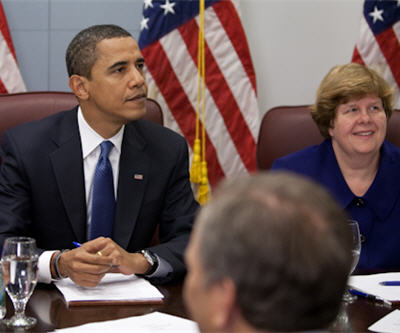The gold standard wasn’t as great as we imagine it: Romer

Christina Romer, former economic advisor to Obama, says that the gold standard was not as great as we imagine it and didn’t provide economic sability.
“As we know in the 1930s gold flows were a big part of what was causing countries to raise interest rates in the middle of a Great Depression for heaven’s sakes,” said Romer in an interview with the New York Times on Friday.
Romer says that unanticipated gold flows that filled the U.S. treasuries at the start of World War II allowed the country to shake off the depression, and says that monetary policy is an unappreciated policy tool that helped the U.S. restart the economy.
“One of the things that people don’t realize is that World War II affected the economy by causing large gold flows to the United States that the president’s treasury department then monetized to increase the money supply.”
Romer says that in the mid-1930s Roosevelt had so much gold coming in leading up to the start of World War II that his treasury department had the ability to bascially increase the money supply without going to the Federal Reserve.
“One of the things I showed in an academic paper is that even though interest rates were very low in the 1930s as they are today, monetary expansion had a very beneficial effect, so that’s a lesson that is going through Ben Bernanke’s head these days.”
It has been nearly 40 years since the U.S. dropped the gold standard.
Christina Romer is Professor of Economics at the University of California, Berkeley and a former Chair of the Council of Economic Advisers in the Obama administration.
Image from the Obama-Biden Transition project
More News
{{ commodity.name }}
{{ post.title }}
{{ post.date }}

3 Comments
JedSmith
Anyone who has studied the Great Depression and economic policy can see that Romer’s statements are pure baloney. This is the quality of the economics ‘profession’ today ?
http://mises.org/daily/3534
LePauvre
The U.S. weakened its gold standard in 1914 when the Federal Reserve was created and, with it fiat money. By 1971 the gold standard was all but abandoned. Nixon simply followed Treasury under-secretary Paul Volcker’s advice and refused to convert fiat dollars, coming from foreign banks, into gold. (There was no other really good choice. The supply of fiat dollars in foreign banks was far greater in value than the pegged price of U.S. gold reserves.)
Alberto Enrique7
NO SOY EXPERTO EN ECONOMIA PERO PREFIERO TENER MIS FONDOS EN BARRA DE ORO Y NO EN PAPELES COMO EL DOLAR O EL EURO O CUALQUIER MONEDA.
eL DLAR CUESTA TRABAJO OBTENERLO 500 DOLARES LA ONZA ? Y SE COTIZA A 1800 DOLARES LA ONZA.lO GUARAS BAJO TU COLCHON O EN UN BANCO PASAN 2 AÑOS DE CUALQUIER CRISIS Y SEGUIRA TENIENDO UN VALOR.
YO CREO QUE NOS QUIEREN DESANIMAR A GUARDAR ORO, MÁS BIEN DE AHORA EN ADELANTE LAGENTE GUARDARA ORO Y NO PAPELES QUE TIENEN UN ENREDO TREMENTO CON LOS BONOS.
PARA LOS PCOS INSTRUIDOS EN ECONOMIA GUARDE ORO Y NADIE LO MANIPULARA